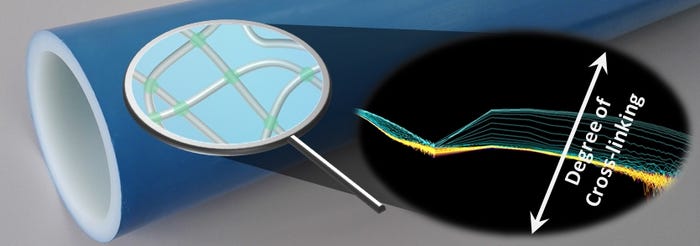Cross-linking plastics is an irreversible process where the long chains of polymers are bonded or linked together. This makes materials tougher and less flexible, and resistant to softening when heated. Cross-linking is therefore a common method that can be used to obtain mechanical, thermal and chemical properties in standard polymers, which are similar to those in high-performance plastics.
November 23, 2015
Cross-linking plastics is an irreversible process where the long chains of polymers are bonded or linked together. This makes materials tougher and less flexible, and resistant to softening when heated. Cross-linking is therefore a common method that can be used to obtain mechanical, thermal and chemical properties in standard polymers, which are similar to those in high-performance plastics.
 It not only improves tensile strength, but can also enhance, among other properties, a polymer’s scratch resistance, temperature and chemical resistance. As a result of cross-linking thermoplastics are turned into thermosets. The best-known examples are cross-linked polyethylene (PE-X), which has become a viable alternative for PVC in pipes, and cross-linked polyamide, which is commonly used in the automotive sector.
It not only improves tensile strength, but can also enhance, among other properties, a polymer’s scratch resistance, temperature and chemical resistance. As a result of cross-linking thermoplastics are turned into thermosets. The best-known examples are cross-linked polyethylene (PE-X), which has become a viable alternative for PVC in pipes, and cross-linked polyamide, which is commonly used in the automotive sector.
There is also a wide range of material systems, which cure through cross-linking. These include, for example, thermosetting materials that are used as matrices in fiber-reinforced composites or in thermoset injection molding and adhesives. The degree of cross-linking and curing is a decisive quality feature in these processes. However, until now, this has mainly been determined by means of wet-chemical analysis, a method relying on chemical reactions between the material being analyzed—the analyte—and a reagent that is added to the analyte.
The main drawback to this method is the length of time required (more than 8 hours in the case of standard testing) before a quantitative result is obtained, and in addition to the elaborate sample preparation involved, the procedure does not allow for 100% complete control.
The German plastics research, testing and training center SKZ (Würzburg) is now examining a different method for determining the degree of cross-linking in thermoplastics and thermosets. Researchers at this center are studying the use of single-sided nuclear magnetic resonance (NMR), a non-invasive material testing approach that, because it is significantly faster than the current standard testing method, also allows for inline process control.
NMR is an advanced non-destructive evaluation technique in which unilateral magnetic resonance techniques are employed to generate information about the internal structure of a sample.
The new research project conducted by the SKZ will explore the potentials and limitations of this measurement method for a process-oriented, non-destructive determination of the degree of cross-linking. This will be done for a broad range of cross-linked and cured material systems, taking into account the respective distinctive features. The aim of the project is to determine whether single-sided NMR is suitable as an alternative for the standard testing method due to the comparatively simple handling and greater mobility, as well as the significantly shorter measuring times.
If so, it would offer a faster, easier method to monitor and characterize thermoset cure reactions.
The project is being funded by the Federal Ministry for Economic Affairs and Energy through the German Federation of Industrial Research Associations within the scope of the program for the Promotion of Cooperative Industrial Research and Development.
About the Author(s)
You May Also Like


